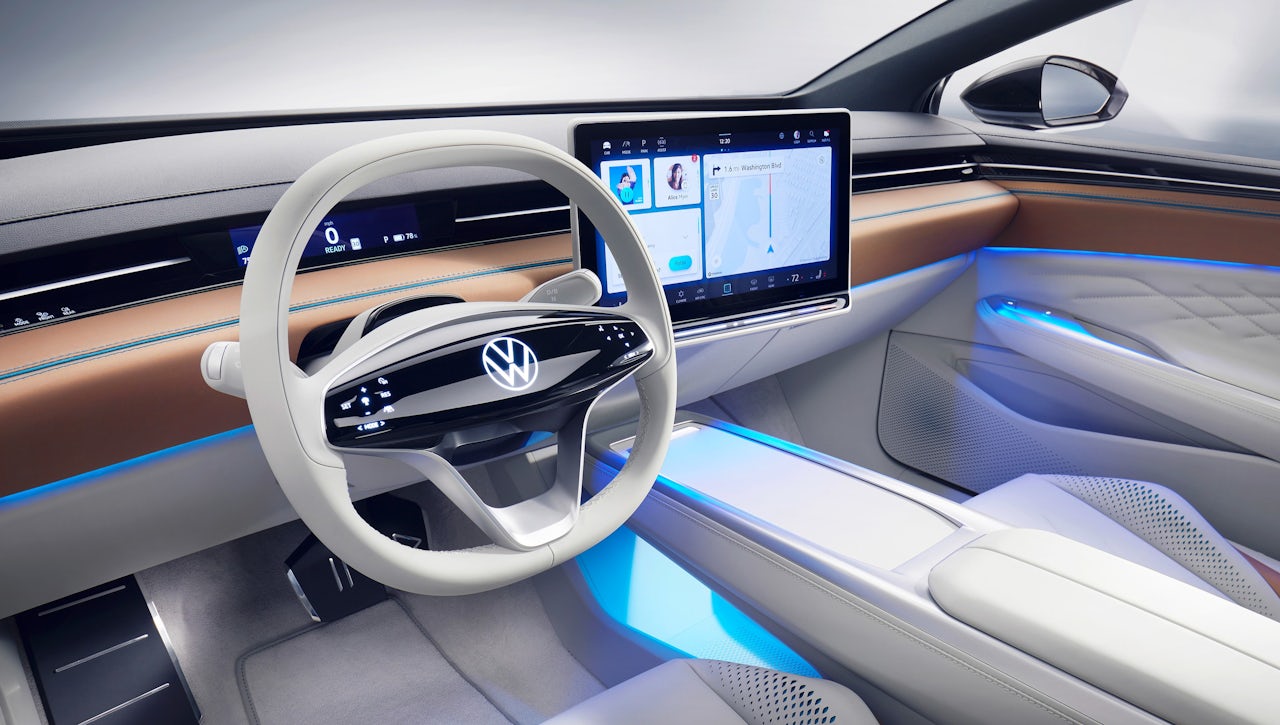The image you see above is the interior of Volkswagen’s SPACE VIZZION concept car, which debuted last week at the Los Angeles Auto Show. The SPACE VIZZION, which I promise you is actually spelled like that and is supposed to be written in all caps, is an all-electric station wagon which a Volkswagen press release claims “heralds the dawn of the all-digital cockpit.” In other words, the middle of the SPACE VIZZION will have a 15.6-inch iPad-lookin’ thing where the radio’s supposed to be, and rather than featuring a bunch of buttons that are impossible to understand, the SPACE VIZZION’s steering wheel will also be an iPad, featuring touch-activated buttons that will also probably be impossible to understand.
The SPACE VIZZION is not the only future car whose interior will rely heavily upon touchscreens, however. The Wall Street Journal notes that Ford’s upcoming Mustang Mach-E electric SUV, which also debuted at the L.A. Auto Show, will feature a 15.5-inch touchscreen, and that the Chinese electric car manufacturer Byton hopes to bring a car called the M-Byte, which features a 48-inch touchscreen that’s as wide as the interior of the vehicle, to market in the U.S. by 2021. Currently, the Tesla Model S features a 17-inch vertical touchscreen, which upon its debut in 2012 sent the rest of the industry scrambling to keep up. As the marketing materials for Volvo’s XC90 SUV boast, “The large screen leads the way.” Whoever at Volvo thought that up had no idea how right they were.
The car industry is iterative by nature, even more so than most industries. Companies are expected to roll out new features, equipment, and designs for their vehicles every single year in order to entice customers into buying new cars rather than used ones. Vehicle infotainment systems — i.e., the screens in the center console of cars that control the GPS, air conditioning, sound, and more — are a very easy place to make those little tweaks to draw in new customers. That���s because right now, infotainment systems mostly suck.
While some current vehicles do have touchscreen infotainment systems, the vast majority of them, especially those on slightly older models, require a counterintuitive system of button-pushing and knob-twisting in order to do something as simple as inputting an address to the GPS or switching over from the radio to Spotify. By putting more and more stuff on a touchscreen — and making that touchscreen is intuitive and easy to use — auto makers are able to say, “Hey look! We put a new thing in the car, so buy the new one instead of the lightly used one from CarMax!”
But there’s another reason why automakers love putting screen in cars: freakin’ ads, baby. An April article in the Wall Street Journal referred to cars as home to “the last unconquered screens,” citing an estimation from the consulting firm McKinsey that car screens are a potentially $750 billion industry. Behold:
On future screens, local restaurants, doctors’ offices and other services could target ads based on typical driving routes. An insurance company could offer lower rates for cautious drivers, while car makers could use system data to offer service on an aging part before it blows. Some envision a world where users could start watching a TV show at home, then with a voice command continue watching the same program in the car. Others are working on allowing users to order and pay for gasoline and coffee on their screens.
One thing that I love about driving is that when I’m behind the wheel, I can’t be connected. I’ve got to look at the road and keep an eye out for oncoming traffic so that I don’t crash into anyone, and the only ads I see are whatever’s on the highway (where I live in North Carolina, that usually means ads for car dealerships, gun shows, and bible stuff). I don’t want the same information-packed experience in a car as the one I get when I’m looking at my phone, and I can only suspect that the future that marketers are envisioning would be incredibly dangerous. After all, there’s good reason to believe that the present is already dangerous enough: in 2016, the New York Times reported that insurance companies believed electronic devices were behind a surprising uptick in road fatalities.
But the biggest problem for car companies doesn’t seem to be safety-related. It’s that at this point, they don’t really make money off of their actual cars. Instead, loans are the chief moneymaker in the auto industry; however, it’s hard to imagine a world where government regulators don’t at some point step in and put an end to the punitive and frequently downright predatory terms attached to those loans before they put consumers in so much debt that they end up helping trigger a recession. Perhaps an increasingly screen-centric cockpit is an auto industry Plan B.
